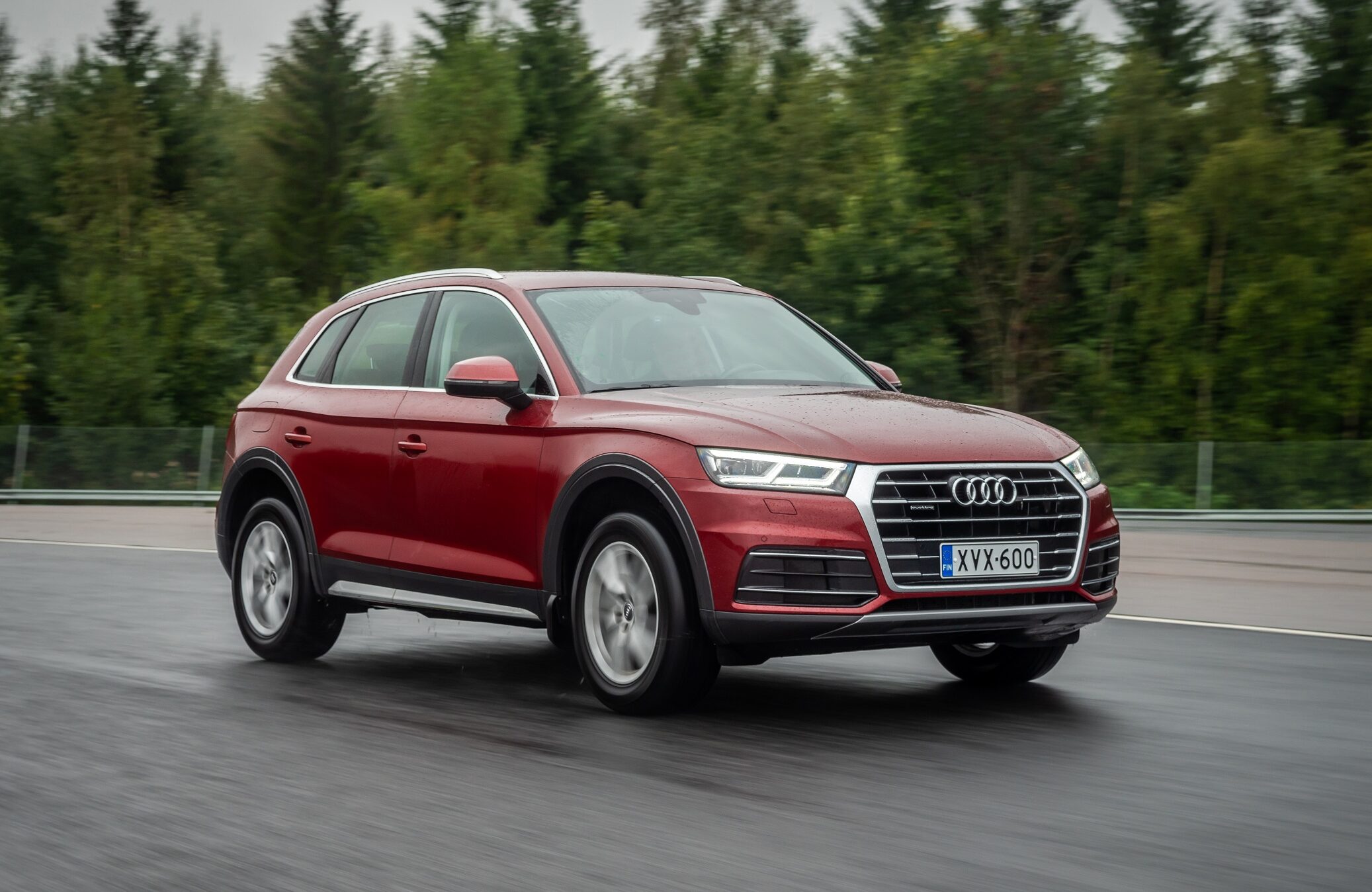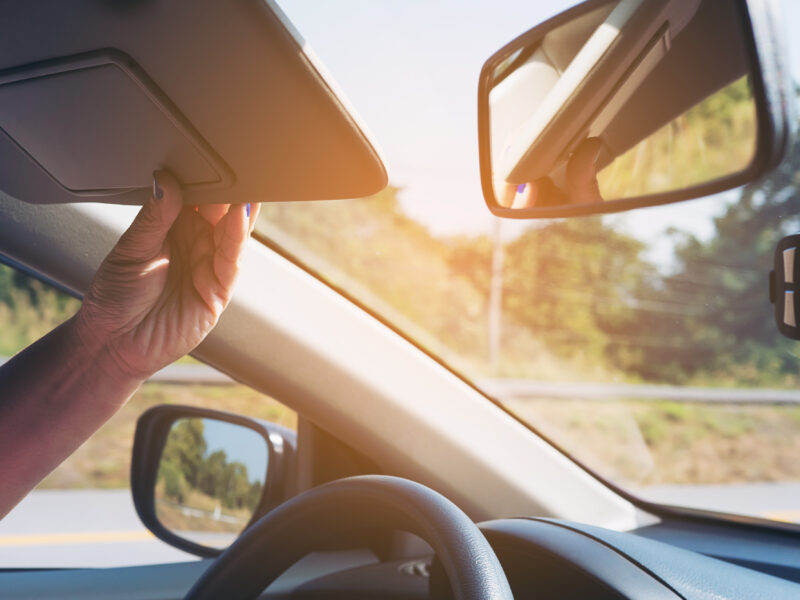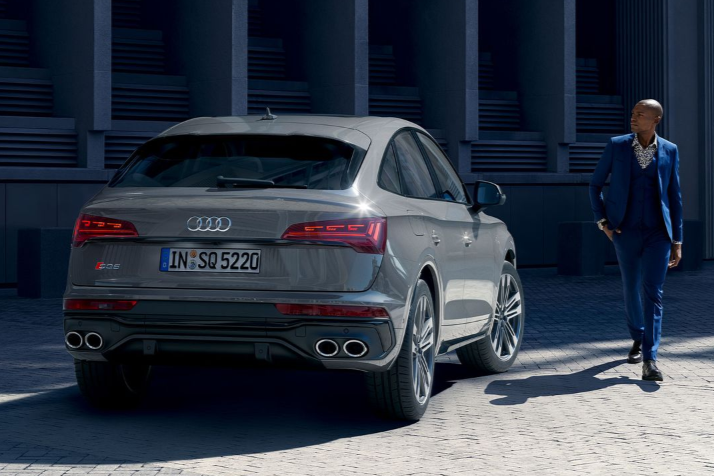All new vehicles sold in Australia must comply with the Australian Design Rules (ADRs), which are minimum standards set by the Australian Government, including safety standards. The Australasian New Car Assessment Program (ANCAP) complements the ADRs. It is an independent body which aims to encourage the highest level of safety for vehicles, and gives consumers information about safety of new vehicles.
ANCAP`s most recent test of the Audi Q5 gave it the highest safety rating of 5 out of a possible 5 stars, meaning it is a very safe vehicle to drive. Therefore, in addition to meeting the minimum safety standards, the Audi Q5 has a number of extra features that contribute to enhanced safety when driving it. Most of these are included as standard, and some are optional extras.
How Are Cars Tested for Safety in Australia?
ANCAP tests cars that are available for sale in Australia and New Zealand in a variety of situations using internationally recognised crash tests.
These are:
- the frontal offset test, simulating crashing into another vehicle at the same speed from an angle to the front of the vehicle.
- the side impact test, simulating a vehicle colliding with the side of the vehicle at 50 km/h.
- the pole impact test, in which the car is propelled into a pole aligned with the driver`s head.
- the pedestrian test, to estimate injuries to pedestrians with the car moving at 40 km/h.
- the whiplash test, a two-part test including measuring the head restraint and a simulation of a rear-end crash to a stationary vehicle.
Dummies are within the vehicle for each test, and these are scientifically analysed afterwards to determine the force (and thus possible injury) that the occupants of the vehicle would encounter in a similar collision in real life. Different sized dummies are used to measure the impact on adults as well as a 6- and 10-year-old child. The vehicle is also physically assessed after the crash test, and this information is combined to give a score for each test.
The Audi Q5 has the highest possible safety rating of 5 out of a possible 5 stars from ANCAP
In addition, ANCAP also requires cars to include safety features and safety assist technologies (SATs) such as airbags and emergency brake assist (EBA).
The crash test scores and the safety features and SATs of the vehicle are all combined into a total score which is then converted into a rating of between 1 and 5 stars. The maximum total score possible is 37, and the minimum score possible for a 5 star rating is 32.5 points.
As mentioned above, the Audi Q5 has received a safety rating of 5 out of 5 stars from ANCAP. The full ANCAP report into the Q5 can be found here on their website, and more detailed information on vehicle testing and the rating process can be found here.
The safety features included in the Q5 are described in more detail below.
Snapshot of Audi Safety Features
| Safety Feature | Summary |
| Airbags | Six airbags to protect driver and passengers in the event of a collision |
| Child seat anchorage points | Anchor points for each of the 3 rear seats |
| All-wheel drive with traction control | Permanent four-wheel drive system, which increases traction and greatly assists the driver to stay in control of the vehicle |
| Autonomous emergency braking (AEB) | Responds to vehicles and pedestrians detected to avoid collisions |
| Driver assistance systems | A range of systems which can activate things like AEB, steering to stay in the lane and warnings about vehicles close by or rapidly approaching |
| Park assist | Automatically steers the car into position while the driver accelerates, brakes or changes gear as required. |
| Adaptive cruise control | This cruise control system maintains the vehicle`s distance from any vehicle in front |
| Head up display | Optional feature which projects key information such as vehicle speed directly in the driver`s field of vision, in full colour onto the windscreen and can be customised by the driver. |
| Exit warning system | Checks for vehicles, pedestrians and bicycles around the vehicle, and when stationary warns not to open those doors that could result in a collision. |
Airbags
Although airbags have been proven to reduce injury and save lives in accidents, there is actually no minimum requirement for vehicles to be sold with airbags in Australia. However, the Audi Q5 comes with six airbags as standard. These are the front driver and passenger airbags, and front and rear head-curtain airbags on each side. Front airbags protect you in the event of a front or rear-end collision (when the person would move forward at speed in the vehicle). The head-curtain airbags protect your head from side impact, and from injury if the vehicle rolls onto its side.
Child Seat Anchorage Points
When travelling with children in Australia, they are required to be seated in an approved car seat for their age and size (check for the requirements in your state or territory as they vary slightly). Car seats must be fixed to an approved anchorage point within the vehicle. The Audi Q5 has anchor points for each of the three rear seats. Top tether anchorage points for each of the rear seats as well as ISOFIX child seat mounting for the outer rear seats are included as standard. Note that there is space for a maximum of two full-size child seats in the vehicle at one time.
quattro-AWD System
quattro (note lower case “q”) is Audi`s permanent four-wheel drive system, and is standard on all Audi Q5s. quattro contributes to increased safety when driving, particularly in poor conditions such as on wet roads. If the wheels on one axle start to lose traction, the drive force is distributed to the axle or wheel with better grip, enabling the driver to stay in control of the vehicle. quattro gives directional stability and enables over- and understeer to be counteracted. It gives improved traction and thereby also improves acceleration. Cornering forces are more balanced which enhances safety as well.
Driver Assistance Systems
The Audi Q5 has a number of driver assistance systems as standard, as well as a few which are optional extras. These contribute to greatly increased safety, as well as making the car easier to drive. It is important to note, however, that none of these features lead to the Q5 being a so-called driverless or autonomous vehicle. Audi states that, as the name suggests, all the driver assistance systems are intended to assist the driver, with the driver still being required to be responsible for driving and paying attention at all times.
Pre Sense City
Pre Sense City is a standard feature of the Q5 which combines Autonomous Emergency Braking (AEB) with a camera in front of the rear view mirror. The camera detects vehicles or pedestrians coming in front of the vehicle, and warns the driver visually and with an alarm if a collision is imminent. The AEB system may then start automatic emergency braking to avoid a collision. The system works within certain limits and up to driving speeds of about 85 kilometres per hour.
Pre Sense Rear
The Pre Sense Rear system is also included as standard. Its purpose is to prevent rear-end collisions, which it does using rear radar sensors. For example, if a vehicle is approaching at speed from the rear, a warning signal will appear in the display and an alarm warning will sound, to alert the driver. The front seat belts are also pretensioned electrically to help prevent injury in case of impact. The windows will start to close and the hazard lights will start flashing quickly to warn traffic.
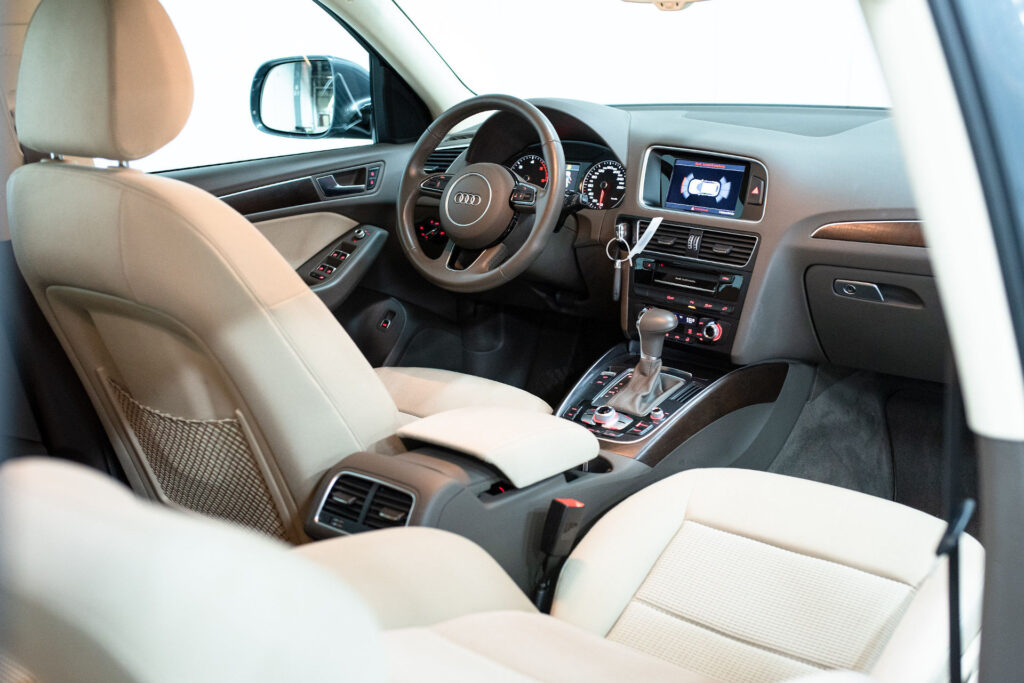
The Audi Q5 has a number of driver assistance systems which contribute to greatly increased safety
Audi Side Assist
Audi Side Assist is another standard feature of the Q5 which aims to prevent collisions to the side of the vehicle. It uses cameras to monitor both sides and the rear of the vehicle. If a vehicle is in the driver`s blind spot, or coming up rapidly from behind, a warning light flashes. This assists the driver to change lanes safely.
Audi Hold Assist
Audi Hold Assist is also included as standard. The driver presses a button to activate this, which holds the vehicle in a stationary position when it is stopped on an uphill or downhill gradient. Audi Hold Assist prevents the car from rolling backwards and potentially colliding when pulling away on an uphill slope.
360° Cameras
Four wide-angle cameras are included as standard and they cover the whole area in the immediate vicinity of the vehicle. The multimedia interface (MMI) displays a complete 360° view of the area around the vehicle from the front, rear and side view cameras. The driver can choose from a range of different views to help avoid collisions when parking or otherwise manoeuvring in tight spaces. The views available include reversing camera, bird`s eye view and corner.
Head Up Display
The Head Up Display is an optional feature which projects key information directly in the driver`s field of vision, in full colour onto the windscreen. This enables the driver to continue looking straight ahead while receiving information about the vehicle speed, any warning messages or other driving-related information such as directions from the navigation system. This means that the driver`s gaze is away from the road for a shorter time than it would be if needing to look down at the console.
The Head Up Display can be customised by the driver as to which content it displays and its height can be adjusted.
Exit Warning System
As well as the driver assistance systems described above, the Audi Q5 also includes an exit warning system as standard. This system uses the sensors of the Audi Side Assist to check for vehicles, pedestrians and bicycles behind and to the sides at the rear of the vehicle. If any of these are sensed when the car has stopped (up to 3 minutes after the ignition has been switched off) the system gives warnings not to open the doors to avoid collision. Red LED lights flash in the door panel and side mirror of the relevant side. In some models the system also delays the electronic door locks from opening for about another second.
The First Aid Kit and Warning Triangle accessories are also included as standard.
Does The Audi Q5 Have Autonomous Emergency Braking?
Yes, Autonomous Emergency Braking (AEB) is a standard feature on all Q5s. It is used by the Pre Sense City system (described above) and responds to vehicles and pedestrians detected.
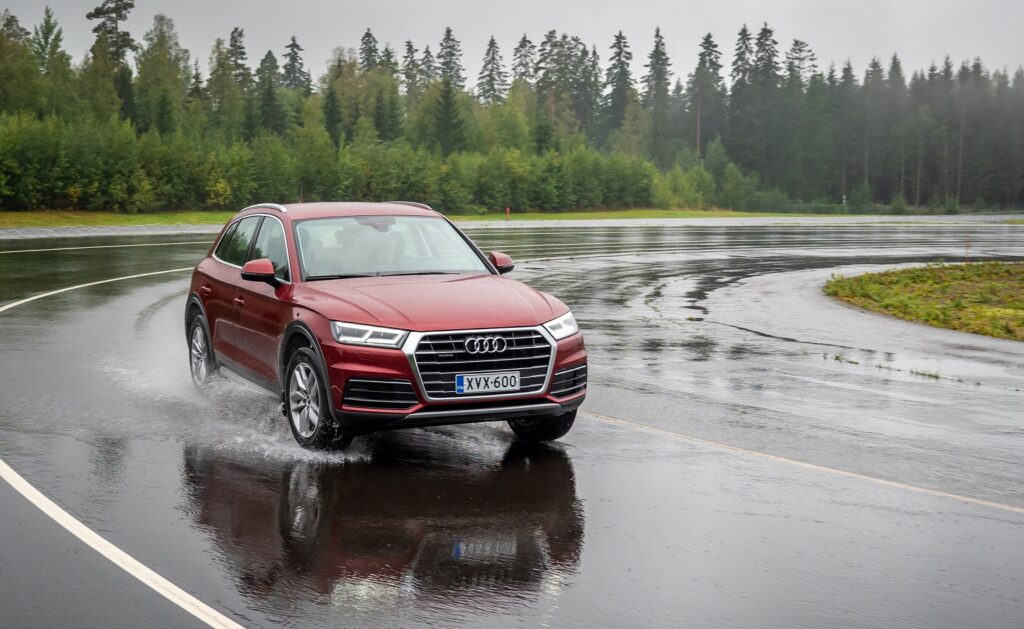
Audi’s quattro-AWD system contributes to increased safety when driving, particularly in poor conditions such as on wet roads.
Does The Audi Q5 Have Park Assist?
The Q5 has park assist as standard. The park assist system can help the driver with reverse parallel parking, leaving a parallel parking space (driving forward), and forward and reverse bay parking.
Park assist, when activated, looks for potentially suitable parking spaces using ultrasonic sensors; it calculates the preferred driving path for parking. Then, once a parking space has been chosen, the driver is prompted to select the correct gear. It then automatically steers the car into position while the driver accelerates, brakes or changes gear as required. The system also warns the driver of any obstacles to the side. This helps prevent collisions while parking as well as making it much easier, especially in tight spots.
Audi Active Lane Assist is also a standard feature of the Q5. The Active Lane Assist system can be activated by the driver and is especially helpful when driving on motorways. The system detects lane markings and assists the driver in staying in their lane by gently intervening in the steering. This increases safety as well as convenience. The Active Lane Assist system operates at speeds above about 65 kilometres per hour.
Does the Audi Q5 Have Adaptive Cruise Control?
Adaptive cruise control comes as standard in all Audi Q5s. This cruise control system maintains the car`s distance from any vehicle in front (multiple different distance levels can be selected by the driver). The Audi Drive Select system can be used to configure acceleration and control as well. The Stop&Go function brakes automatically until the vehicle is completely stationary, and it then begins to accelerate again automatically when clear.
The adaptive cruise control works at speeds ranging from approximately 0 to 250 kilometres per hour.
List of Standard and Optional Safety Features of the Audi Q5
| Safety Feature | Standard or Optional |
|---|---|
| Airbags | Standard |
| Child seat anchorage points | Standard |
| All-wheel drive with traction control | Standard |
| Autonomous emergency braking (AEB) | Standard |
| Driver assistance systems | Standard |
| Park assist | Standard |
| Adaptive cruise control | Standard |
| Head up display | Optional |
| Exit warning system | Standard |
Disclaimer: Information in this article is general in nature and current at the time of publication, and no warranty is offered as to its accuracy or completeness.
